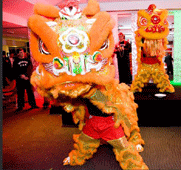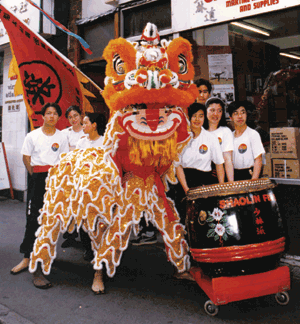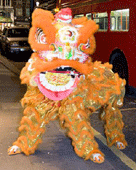|
The Chinese Lion Dance Tradition
|
||||
 |
 |
 |
 |
 |
|
The Chinese Lion Dance has a tradition in China dating back a few thousand years. There are numerous versions as to its origin, but the most popular and obvious reason is that the Chinese needed something for protection, to give them good luck, prosperity, health, longevity and blessing. These objectives and concepts gave birth to Feng Shui and subsequently the Chinese Lion and Dragon. To empower the Chinese Lion to do it duty, it is brought to life by the process of 'dim jing' or dotting the lion. This process involves a ceremony in front of a Daoist or Confucianist alter, usually on an auspicious day. However this tradition is not usually followed in the West as most kung fu schools do not even have a full time gym or place. Some have no idea how to perform the ceremony as they are not spiritually trained to do so. There are different versions of 'Dim Jing' Some translated it as dotting the lion's eyes, which is quite incorrect, as it is not just the eyes being 'dim'. Nevertheless it is their 'way' of bringing the Lion to life. The spiritual ceremony starts by placing the new lion costume in front of the alter. An example of such an alter may sit Kuan Yin (Guan Yin), Chai Tin Tai Sing (Monkey Sage) to her right and Kwan Kung (Gwan Gung) to her left. Kwan Kung sits on the 'Left Green Dragon' side, which represents the peaceful side, while the Monkey Sage sits on the 'Right White Tiger' side, which represent the warrior side. The alter will have been prepared and fresh tea and fruits replace the old. Nine joss-sticks will be lighted to invoke the deities sitting on the alter. If it is a Kwan Kung Lion to be dotted, it is natural to invoke Kwan Kung to perform the dim jing. The drum will be softly rolling together with the clashing of the cymbals and hitting of the gong. To do that cinnabar powder (jee sa or red pearl sand) soaked in water will be used. The master will dip the bamboo brush into the jee sa and dot the mirror on the front of the lion's head to give its initial spiritual essence . This is known as the 'third eye'. The brush then dot the 'nose' to bring it to life so that it can breathe, which is followed by the inside of the mouth, which will open slowly as it starts to breathe. The 'ears' comes next followed by the 'eyes' 'head' 'neck' 'body' 'tail' and finally the 'limbs' Initially the Lion moves slowly as it recovers its stances and balances. The music grows louder as the lion comes to live. It then pays homage to the dieties by giving three bows; the first to the left (Green Dragon), the second to the right (White Tiger) and the third to the centre. Then it performs the routine of eating the greens (chian) and spilling them out in three directions. The traditional Lion is usually referred either as a Kwan Kung (Guan Gung), Lau Bei (Liu Bei) or Cheong Fei (Zhang Fei) Lion. Kwan Kung will be denoted by a red costume, Lau Bei by a mixed-coloured and Cheong Fei by a black costume. The Cheong Fei lion is a 'fighting lion', but this is now shunned in favour of a Kwan Gung, Lau Bei, Chew Tzu-Lung (either a Green or Blue costume), Silver or Gold Lion. |
||||
|
To hire a Lion Dance Team please contact Grandmaster Yap Leong on 07768321092 or email: info@martialarts.co.uk ©Yap Leong |
||||